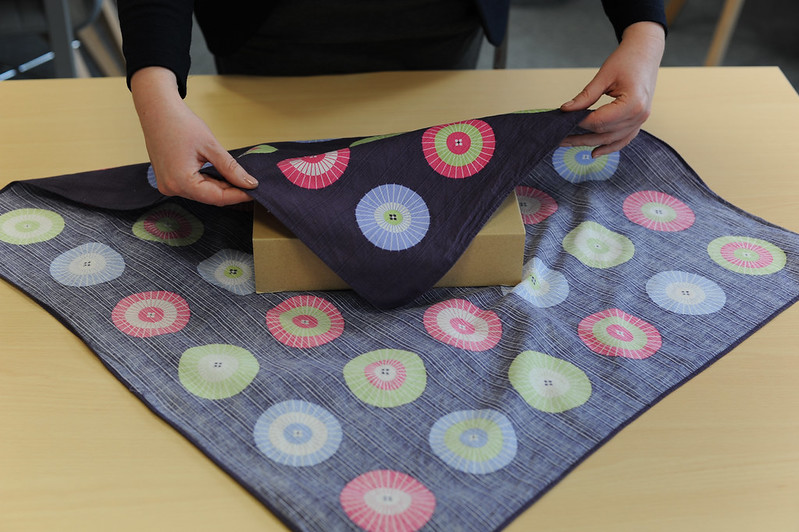
Wrapping with Fukusa
Giving gifts is a common Japanese custom. Different types of gifts are given depending on the occasion. A lot of attention is also given to the wrapping of presents. Fukusa is a Japanese textile used for gift-wrapping and also used in Japanese tea ceremony.
Fukusa in a Japanese tea ceremony can refer to several types of silk cloth such as tsukai fukusa which are usually squares of silk used to ritually purify tea utensils during tea-making, ko-bukusa which are small squares of brocaded silk used by hosts and guests to handle tea bowls, and dashi fukusa which are larger squares of silk also used for handling tea bowls.
In Japan, gifts were traditionally placed in a wooden box or lacquer tray, and a fukusa was draped over it. The design of the fukusa was chosen depending on the occasion. This was an important part of the Japanese gift-giving ritual. Using a fukusa became a widespread practice during the Edo or Tokugawa period (1615-1867).

The motif or scene depicted on a fukusa indicates the occasion, and the more elaborate the design the wealthier the giver. After the wrappings are admired by the recipient, the fukusa along with the box and tray, are returned to the giver. When the gift is presented to a high official, the fukusa is not always returned. This was a means to subtly control the wealth of lords and samurai.
During the 18th century, the art of the fukusa reflected the aristocratic minority of Japan such as the daimyo and samurai. The designs of the cloth held very subtle cultural references that were recognized only by the educated members of society. The members of these classes usually resided within the cities of Edo (Tokyo) and Kyoto as well as the surrounding areas.
During the 19th century, the merchant class moved up the social ladder and began following the same customs of the aristocracy, including the use of fukusa. Family crests were added to the lining of the gift covers and tassels were placed at each corner so the gift cover can be picked up without touching the fabric.
Artists were commissioned to design textiles for fukusa and each work was an original creation. Satin silk was the fabric preferred for embroidery with gold-and-silver-wrapped thread as well as yuzen (dyed cloth), chirimen (crepe silk), and Tsuzure-ori (nail weaving).
Nowadays, fukusa are rarely used, and when they are, it is mostly within Tokyo and Kyoto for presents for couples getting married.
Take a look at this YouTube video by usagiicecream on how to fold the fukusa in a tea ceremony:
*Furoshiki is another type of cloth used for gift giving in Japan. It comes in all kinds of sizes, fabrics, and designs.
